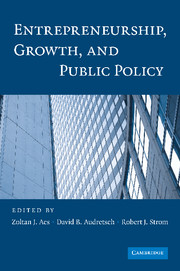Book contents
- Frontmatter
- Contents
- Contributors
- Acknowledgments
- ENTREPRENEURSHIP, GROWTH, AND PUBLIC POLICY
- 1 Introduction: Why Entrepreneurship Matters
- PART I THE ROLE OF ENTREPRENEURSHIP IN INNOVATION
- PART II LINKING ENTREPRENEURSHIP TO GROWTH
- 6 Entrepreneurship and Job Growth
- 7 Entrepreneurship at American Universities
- 8 Scientist Commercialization and Knowledge Transfer?
- 9 Why Entrepreneurship Matters for Germany
- PART III POLICY
- Index
- References
8 - Scientist Commercialization and Knowledge Transfer?
Published online by Cambridge University Press: 05 June 2012
- Frontmatter
- Contents
- Contributors
- Acknowledgments
- ENTREPRENEURSHIP, GROWTH, AND PUBLIC POLICY
- 1 Introduction: Why Entrepreneurship Matters
- PART I THE ROLE OF ENTREPRENEURSHIP IN INNOVATION
- PART II LINKING ENTREPRENEURSHIP TO GROWTH
- 6 Entrepreneurship and Job Growth
- 7 Entrepreneurship at American Universities
- 8 Scientist Commercialization and Knowledge Transfer?
- 9 Why Entrepreneurship Matters for Germany
- PART III POLICY
- Index
- References
Summary
Introduction
How and why do scientists decide to commercialize their scientific research? The answers to these questions are important not only to institutions and scientists engaged in research, but also to policymakers trying to promote economic growth. New Endogenous Growth models and theories highlight the central role that investments in scientific research, or knowledge, play in generating economic growth (Romer, 1986; and Lucas, 1993). More recently, policymakers, serving local communities, states and nations have observed that these investments in knowledge do not automatically generate economic growth. Rather, what Acs et al. (2004) and Audretsch et al. (2006) term the knowledge filter prevents or slows employment creation and economic growth that could otherwise result from public and private investments in science and research. The combination of large investments in research with low rates of economic growth and employment generation, first found in Sweden, was called the Swedish Paradox. Later as it was found in other European nations, the problem was redubbed the European Paradox. Acs et al. (2004) and Audretsch et al. (2006) identify the commercialization of science and research as the missing link in the process of economic growth. In the absence of scientist commercialization of research, investments in science and research will not generate economic growth or jobs.
The purpose of this study is to understand how and why scientists commercialize research. We do this by analyzing the propensity of scientists receiving National Cancer Institute (NCI) grants to commercialize their research.
- Type
- Chapter
- Information
- Entrepreneurship, Growth, and Public Policy , pp. 176 - 201Publisher: Cambridge University PressPrint publication year: 2009
References
- 2
- Cited by

